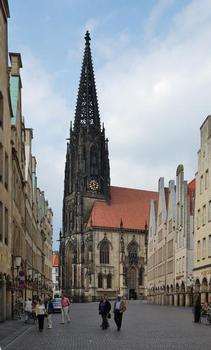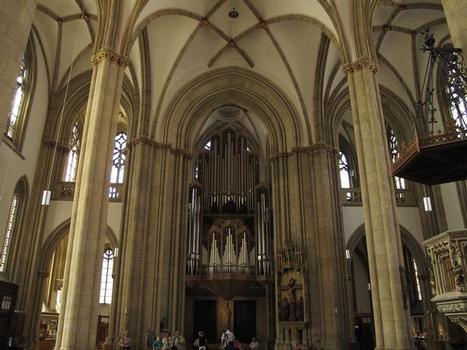General Information
| Name in local language: | Lambertikirche; Sankt Lamberti |
|---|---|
| Beginning of works: | 1375 |
| Completion: | 1526 |
| Status: | in use |
Project Type
| Function / usage: |
Church |
|---|---|
| Material: |
Masonry structure |
| Architectural style: |
Gothic |
| Structure: |
Rib vault |
Awards and Distinctions
Location
| Location: |
Münster, North Rhine-Westphalia, Germany |
|---|---|
| Coordinates: | 51° 57' 47" N 7° 37' 43" E |
Technical Information
There currently is no technical data available.
Excerpt from Wikipedia
St Lambert's Church (German - St. Lamberti) is a Roman Catholic church building in Münster (Westphalia) in Germany, dedicated to Lambert of Maastricht. Its present building is the most significant example of Westphalian late Gothic architecture. It lies on the north side of the Prinzipalmarkt (main market square) in the city centre. Until the early 20th century, the Roggenmarkt (which also borders the church) contained the Drubbels district of housing. To the church's east lies the Alte Fischmarkt and the Salzstraße, whilst between the church and the Salzstraße is the Lambertikirchplatz with the Lambertibrunnen.
Three iron baskets hang from the church tower - in 1536 these were used to expose the corpses of Jan van Leiden, Bernd Krechting and Bernd Knipperdolling after they were publicly tortured and killed in the Prinzipalmarkt for leading the Münster Rebellion. In 2007 the twentieth episode of the TV-series Wilsberg, 'Die Wiedertäufer' ('The Anabaptist'), was filmed at the church.
History
To 1375
Around 1000 there was a wooden church in the Kaufmannssiedlung in front of the Domburg, near the city's first cathedral. Just before 1100 the wooden church was rebuilt in stone. This was probably destroyed in 1125. In 1150 it was replaced by a vaulted single nave stone church in the Romanesque style, retaining the previous church's west tower and extending it from 17 to 21 metres high by adding two more storeys to its original one. In 1170 Münster was granted the rights of a city and nineteen years later portions of the single parish served by that church were split off to form the parishes of St Ludgeri, St Aegidi and possibly St Martini.
In 1270 a three-nave Gothic hall church was built on the site. The west tower was extended again at the same time, this time with an additional storey taking it up to 40 metres. The facade of the 1270 extension contains a 1302 Jewish gravestone looted during the 1350 Pogroms.
Late Middle Ages
The city's merchants financed the construction of the present building as a marketplace church and a city church. The foundation stone was laid in 1375. Since 1379 a 'Türmer' has blown a horn from the church tower every half hour between 9 pm and midnight from Wednesday to Monday. Since 2014 the post has been held by Martje Saljé.
The choir was completed in 1422 and the octagonal south choir chapel in 1448. The nave was built in several stages from 1450 onwards, including the main southwest doorway with a relief of the tree of Jesse (the original of which is now in the Bode Museum in Berlin). The vaulting of the choir and nave was only completed in 1525. The original plans included a new tower to replace the medieval one, but this proved too expensive and instead yet another floor was added to the existing tower, bringing it to 50 metres high and also adding a pointed cupola, which survived until the 19th century.
1900-present
By the end of the 19th century, the foundations were no longer able to support the west tower (by then three times its original height) and it was in danger of collapse. Some argued for its preservation, but this was prevented by the Kulturkampf between the Kingdom of Prussia and the Roman Catholic Church. Instead it was decided to demolish and rebuild part of the tower. Bishop Johann Georg Müller commissioned Arnold Güldenpfennig to carry out the works in 1865, but he failed to begin the project and so in 1870 a competition was held to decide his replacement - the only differences between the competing plans were their approaches to the upper storey. August Rincklake won the competition and begun work in 1871 by adding a new tower and replacing the church roof. The old tower was totally demolished in 1887 and the following year a 90.5 metre high new neo-Gothic was begun to designs by the diocesan architect Hilger Hertel, deliberately designed to look different to the old tower. On Hertel's death in 1890 (a sculpture of him was added to the interior of the base of the tower) the tower had reached the same height as the church. His son Bernhard completed it to its full height between 1895 and 1898. It was a smaller copy of the towers of Freiburg Minster, though it was also influenced by the new towers of Cologne Cathedral, completed in 1880.
Statues of the Four Evangelists were installed around the main west door in 1911 - the figure of John has the face of Friedrich Schiller and that of Luke of Johann Wolfgang von Goethe, marking the Geheime Rat's visit to Münster in 1792. One pillar of the octagonal tower, the roof and the eastern vaulting were destroyed during World War Two. The church hosted two of the three 1941 sermons by bishop Clemens August Graf von Galen against the Nazi Aktion T4 - he had been its parish priest from 1929 to 1933. In June 1942 the bells were taken down. A temporary roof was installed in 1946 and all the war damage had been repaired by 1959. The roof was replaced at its higher late medieval level rather than the heavily articulated neo-Gothic ceiling and the sacristy was rebuilt in the modern style, but otherwise the lost portions were rebuilt as they had been pre-war, following the 19th century rebuilding by Hans Ostermann. The main west door has not been opened since a light-installation from 31 October to 1 November 2017.
Text imported from Wikipedia article "St Lambert''s Church, Münster" and modified on July 23, 2019 according to the CC-BY-SA 4.0 International license.
Participants
Currently there is no information available about persons or companies having participated in this project.
Relevant Web Sites
- About this
data sheet - Structure-ID
20019413 - Published on:
10/02/2006 - Last updated on:
09/09/2024






